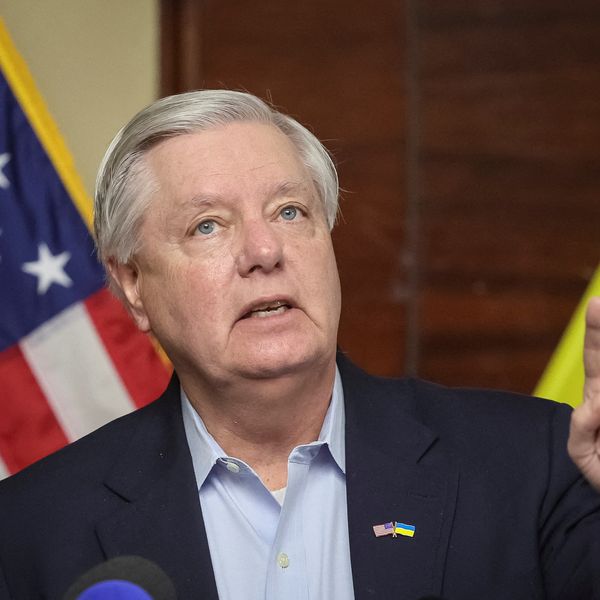Amid the Russian military buildup on Ukraine’s borders, the all too familiar voices of confrontation in the media and U.S. government have risen to call for collective action against a hypothetical invasion. Although admitting direct military confrontation by NATO is not possible since Ukraine is not a member state, the Biden administration has promised crippling sanctions against the Russian bear should it lash out.
Shortly before Christmas, following a virtual summit between President Biden and Vladimir Putin, the Russians laid out a series of demands including promises from the West not to admit any former Soviet republics to NATO, and most significantly, “withdrawing military infrastructure it has placed in Eastern European states after 1997.” On Sunday, before high-level talks between the U.S. and Russia were set to begin on Monday, Secretary of State Blinken said they did not expect any "breakthroughs." Meanwhile, the Russians said they were not willing to make any concessions to Washington demands in the meetings, which would continue through the week as NATO officials met with Russian counterparts in Geneva.
A "kicking the can" moment on the part of the Americans will not suffice, however, warns Anatol Lieven, as the Russians "are prepared to fight ... and the United States is not."
Russia is not likely to launch another 1950s-era tank assault to smash Kiev, nor are they interested in retreating from Ukraine in the face of ever-growing NATO encroachment. The Blob, along with antiquated thinking at the Pentagon, has obscured any serious analysis of Russia’s actions or recent successes, intentionally leading the public to believe a big war is just weeks or days away. Russia has formulated a more nuanced approach while still posturing for big war as a bargaining chip. By keeping the pressure dialed up, they can win a long-game betting on US and European retrenchment from their former satellite nation.
For illustration, consider the difference between Russia’s first war against Chechnya in the 1990s and the annexation of Crimea in 2014 and the subsequent war in eastern Ukraine. Following Chechnya’s declaration of independence in 1991, the Russian military under Yeltsin invaded in 1994 with the standard Soviet sledgehammer: columns of tanks and armored personnel carriers, air strikes, and artillery and rocket barrages. Despite a pyrrhic victory in seizing Grozny in a month’s long armored assault, Russian forces found themselves immobilized and under constant guerilla style attacks from fighters who had infiltrated numerous sections of the city. Even after leveling many parts of the town and killing thousands of civilians, the Russians were stalled and had to sue for peace in 1996.
Fast forward to February 2014 following the so-called Maidan revolution and the abdication of the pro-Russian President Viktor Yanukovych. The Russian lease of their warm water naval base in Sevastopol on the Crimean peninsula was now in question. Covertly in theory but overtly in reality, Russia began shuttling in the now infamous “little green men”, some wearing uniforms, some not, into established Russian bases in Crimea. Once enough men were in place at the end of February, they seized the Parliament building and established checkpoints to block access from mainland Ukraine. Following a “referendum” in March, Crimea was officially added to Russian territory. As the BBC reported shortly after the vote, the Crimean operation was the “smoothest invasion of modern times. It was over before the outside world realized it had even started.”
US defense officials and think tanks have analyzed Russia’s success in the last several years to understand and recommend counters to Moscow’s new approach to military and strategic policy. A well-written analysis from Rand Corporation in 2017 identified the key characteristics of hybrid war as economizing the use of force, persistence in duration, and population-centric in focus.
The role of information and narrative control take center stage in these campaigns. As stated in an Institute for the Study of War paper in 2020, all “actions, up to and including the use of conventional military forces in regional conflicts, are subordinate to an information campaign.” Information can be used offensively or defensively. In Georgia in 2008, a massive Russian cyber-attack targeting media and government infrastructure coincided with the Russian ground invasion, paralyzing the government and military response. (For the record, the Georgians struck first by shelling South Ossetia.) Defensively, Russian media outlets churned out propaganda to frame the conflict as a reaction to Georgian aggression in South Ossetia. The Russian Chief of the General Staff Valery Gerasimov, in a widely circulated paper published in 2013, claimed “the need for modern Russian warfare to utilize information in warfare in a 4:1 ratio of nonmilitary to military measures.”
In April of 2014, a mere month after the seizure of Crimea, Russian separatists, clearly with the backing of Moscow, began a low-level war against Ukraine in the eastern Donbas region that still rages today. Americans must understand that Ukraine is many orders more important to Russia than it is to the U.S. government. As stated in The Limits of Partnership, “for Moscow, Ukraine is an existential question.” Even prior to 2014, Putin had plans for a greater Eurasian Union that include Ukraine. Not surprisingly, Army Lt. Gen. Ben Hodges, former commander of U.S. Army Europe, thinks the next Russian incursion will make the little green men of 2014 seem “cartoonish.” Is this plausible?
Looking at rhetoric and information first, there does appear to be narrative-shaping underway. Over the Christmas weekend approximately 10,000 Russian troops were withdrawn from the Ukraine border while Moscow also signaled that it expected a U.S. response to its security guarantees sometime in January. Meanwhile in late December, the Guardian reported that Russian defense minister Sergei Shoigu was accusing an unnamed private U.S. military company of procuring chemical weapons and planning to launch a ‘provocation’ in the east Ukrainian cities of Avdiivka and Krasny Liman. Clearly Washington will not entertain withdrawing its forces from NATO countries in Poland or the Baltics that buffer Russian client states without an equivalent quid pro quo, so what is one to make of Putin’s demands and Shoigu's claims? Is this just a casus belli? Possibly, but likely not.
As Sun Tzu famously said, “know your enemy and know yourself.” The United States will be spending $777 billion dollars on defense, while Russia's latest budget (2021) was just $61.7 billion. Their approach, while failing to completely subdue the present Ukrainian government’s shift to the West, has destabilized the country enough to forbid NATO membership or a cohesive challenge to contested territory in the Donbas after seven years. Imagine if Mexico seized the port of San Diego and the United States government was unable to retake it. Putin clearly desires more than just a slice of Ukraine to be aligned with Moscow, so the present situation, given Russia’s weakness against NATO and the EU, is arguably effective.
As stated in the above Rand study, the 2018 National Defense Strategy “focused largely on the conventional military balance” and recommended a corresponding improvement in US capabilities in response. Calling this response “insufficient” but not wrong, the study accurately notes that it “understates Russian efforts to circumvent rather than directly challenge NATO’s capabilities.” Whether or not the United States should be challenging Russia in Ukraine is irrelevant to the fact that the Blob’s approach just can’t effectively counter Russia’s strategy.
Whatever Russia’s endgame is in Ukraine, a conventional armored invasion is almost certainly off the table. First, the present Ukrainian military is better organized, motivated, and equipped than it was in 2014. At 255,000 strong and armed with U.S.supplied Javelin anti-tank missiles, the Ukrainian military would likely inflict significant losses on Russian armor or personnel carriers. Tank columns don’t work like they did in Hungary in 1956.
Second, they would be playing defense on their home turf against a Russian force that is estimated at around half that size at most. As Marine officers are taught, defense is the stronger form of combat. While Russia has engaged sympathetic locals in the eastern half of Ukraine, any conquest of Kiev would pit their forces against equally sympathetic Western aligned proxies, fighting their own partisan war.
Putin could indeed take Ukraine, but at the cost of incredible bloodshed. Russia’s approach to strategic and military policy in the last 15 years leads one to believe this is not going to happen.
Losers tend to learn, and following the Cold War, Russia has adapted to resist and repel the encroachment of the United States and NATO despite doing so from a position of material and financial inferiority. While a ground invasion of Ukraine isn’t off the table, the last 15 years leads one to believe Moscow is playing for the long haul using a combination of destabilization, diplomatic negotiation, and the current military buildup to eventually return Ukraine to their orbit of influence.














